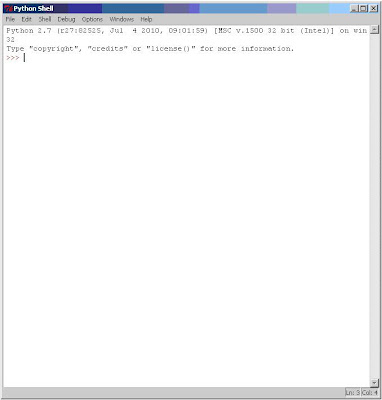There are a few really good links for help on Python programming. One is from the Python website itself here. As well as from the Introduction to Computer Science and Programming course on MIT's OpenCourseWare (OCW) website. The MIT OCW website has many classes and programs you can go through free of charge and look very interesting. Harvard also has a similar setup here and it looks like they use C whereas MIT is using Python in instruction.
If you want to follow along with me you should go to the Python website and download version 2.7 If you prefer to use 3.0 that's fine but 2.7 is backward and forward compatible whereas 3.0 has gotten rid of some things that I may be using since I'm following the MIT OCW course, recorded in 2008.
Once you've installed Python, bring up the Python Shell also called IDLE (Python GUI) which should look like this:
 |
| IDLE (Python GUI) / Python Shell |
Now, onto the lesson: Variables are memory locations, the contents of which may vary throughout the program. For example:
>>>numberOne = 1 #Hit Return
*Note - # is Python for comment. Meaning, typing it would not hurt, but does nothing for you. I am only letting you know here to hit return to enter 1 as the value for numberOne.
This sets a memory location, nicknamed "numberOne" to the value of 1. To write this in pseudocode you can write it the same "numberOne = 1" since this is a simple statement, or to be more clear:
set numberOne = 1
Remember I said variables can change. We can now type in the Shell:
>>>numberOne = numberOne + 1
This may look weird, but it should be simple enough to see what is happening. We are taking numberOne and setting it equal to numberOne + 1, or just adding one to it. If you type:
>>>print numberOne
You should now get the result: 2.
The last thing I want to mention briefly is the data type of this number:
2
The number 2 is an integer or int, and has no decimal value. In Python, and most other programming languages, this is important. The type is decided when you initialized the variable. To make this make sense try typing 7/2 into the Python Shell and hit return. Notice the answer is not 3.5 but 3! An integer has no decimal value, and your attempt at dividing, which would create a decimal is ignored and it throws out the remainder.
If you are writing a program that requires the decimal values, you can use what is called a floating point or float. To make it a float, just type 7.0 (the .0 part making it float) and divide that by 2. What do you see? 3.5!
Be careful when writing your programs that you keep track of this. There are ways in many programming languages to change the type, but doing so unnecessarily can cause leaks and bugs in your program.
Lastly, a neat trick to see the remainder of the integer division is by using the % sign. Using % divides one side by the other and gives the remainder.
>>>7%2
1
Tomorrow I'll try and post something a little more... interesting to program. Until then enjoy the tutorials and let me know what you think!

No comments:
Post a Comment